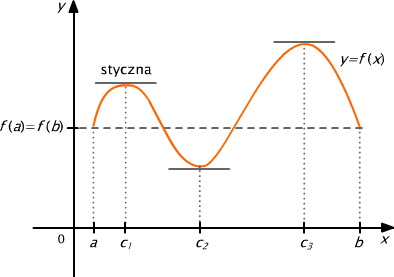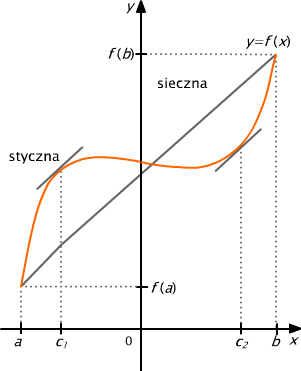| next ≈ |
Assume a function f satisfies the following conditions:
Then there exist a point c∈ (a, b) such that f ' (c) = 0, provided f (a) = f (b).
Proof. If the function f is constant in the interval [a, b], then f '(x) = 0 for every x∈ (a, b), and thus the claim holds.
Suppose then f is not constant. By the Weierstrass theorem of lecture III there exist points c, c' ∈ [a, b] such that
![]()
Since f is not constant, at least one of the inequalities:
![]()
holds. Assume that the second inequality is valid (for the first inequality the proof is very similar).
Because f (a) = f (b), then c∈ (a, b). Point c was chosen in such a way that for any h such that c + h ∈ [a, b] we have f (c+h)- f (c) ≤ 0 i.e.
![]()
Hence, because f '(c) does exist, by the theorem on inequality preservation of lecture III, we have
0 ≤ f -' (c) = f' (c) = f +' (c) ≤ 0, which implies that f ' (c) = 0.
Example
Let f (x) = cosx, x ∈ [π / 2, 3π / 2]. This function satisfies Rolle's theorem assumptions. Thus there exists a point c∈ [π / 2, 3π / 2] such that f ' (c) = 0. It is plain to see that c = π.
The figure below displays the graph of a function that satisfies Rolle's theorem assumptions:

Fig. 5.1
The tangent to the graph at the point a = (c2, d) is parallel to the x-axis. It means, that the slope of the tangent is equal 0, i.e., f ' (c2) = 0.
The mean value theorem of differential calculus
Assume a function f satisfies the following conditions:
Then there exists a point c∈ (a, b) such that
![]()
The mean value theorem is more general than the Rolle's theorem:
If a function f is differentiable in an interval (a, b), then for each secant of its graph there exists a tangent that is parallel to it. This fact becomes clearer, if we notice that the number (f (b) - f (a)) / (b-a) is the slope of the straight line passing through the points (a, f (a)) and (b, f (b)), whereas f ' (c) is the slope of some tangent to the graph of the function f. This is illustrated below.

Fig. 5.2
Example
We will use the mean value theorem to prove the inequality
|arctgb - arctga | ≤ |b-a | for a, b ∈ R.
It holds trivially for a = b. We will consider the case a < b (for a > b the proof is similar). The function f(x) = arctgx satisfies the assumptions of the mean value theorem in the interval [a, b]. Transformation of the formula appearing in the theorem gives, for some number c, a < c < b
|arctg b - arctga | = | b-a |·|f ' (c) | = | b-a | · (1/(1+c²)) ≤ |b-a | because 1/ (1+c²) ≤ 1 for c ∈ R.
The following corollaries can be derived from the mean value theorem:
f (x) = g (x) + c for every number x ∈ (a, b).
a) f (x0) ≤ g (x0)
b) f ' (x) ≤ g ' (x) for every x ∈ P, x > x0, then f (x) ≤ g (x) for every x ∈ P, x > x0.
If any of the inequalities of assumptions (a) or (b) is strict, the inequality in the claim becomes strict as well.
Example
• We will prove the inequality
arcsinx + arccosx = π / 2 for x∈ [-1, 1].
Consider the function f (x) = arcsinx + arccosx, which is continuous in the interval [-1, 1]. For x ∈ (-1, 1) we have:
![]()
Hence f is constant in the interval [-1, 1]. Since f (0) = π / 2, we find that
f (x) = π / 2 for x ∈ [-1, 1].
• We will prove the inequality
sinx < x for x > 0.
Consider the functions f (x) = sinx and g (x) = x, Df = Dg = R. Let x0 = 0 and P = [0, 1]. Obviously f (0) = g (0), f ' (x) = cosx ≤ 1 = g ' (x) for x ∈ P, x > 0. Thus by the corollary (3) we obtain sinx ≤ x for x > 0. Since for 0 < x ≤ 1, the inequality f ' (x) = cosx < 1 = g ' (x) holds, for 0 < x ≤ 1 we have sinx < x. The last inequality is clearly valid for x > 1.
| next ≈ |